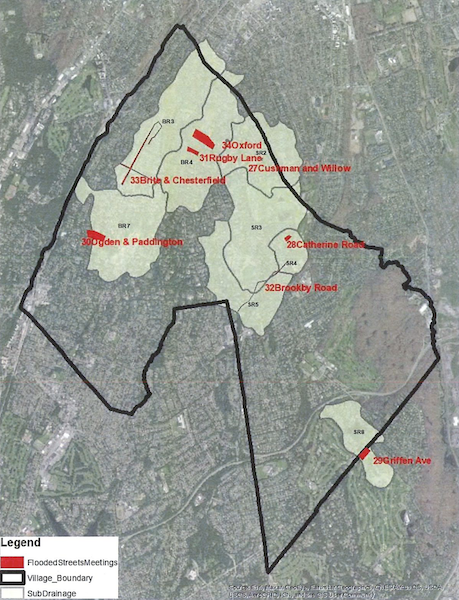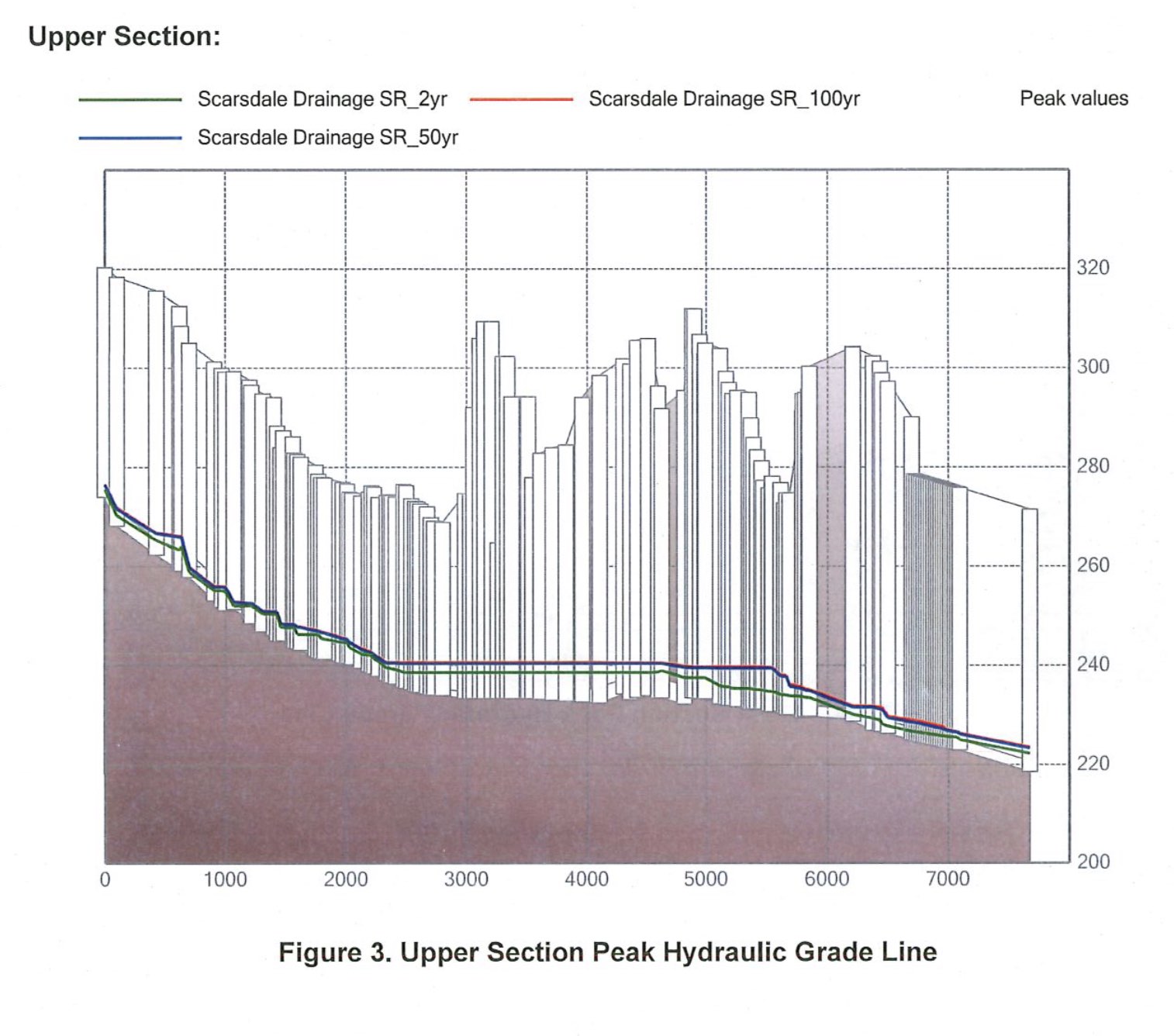Remediating Stormwater: What to do First?
- Wednesday, 06 December 2023 13:15
- Last Updated: Wednesday, 06 December 2023 13:20
- Published: Wednesday, 06 December 2023 13:15
- Joanne Wallenstein
- Hits: 2840
 Scarsdale has been experiencing some record rainstorms, putting the Village’s system of storm drains, pipes, culverts, sewers and retention basins to the test. On Friday September 29 the Village received 5 inches of rain in less than 24 hours and many roads and homes were inundated.
Scarsdale has been experiencing some record rainstorms, putting the Village’s system of storm drains, pipes, culverts, sewers and retention basins to the test. On Friday September 29 the Village received 5 inches of rain in less than 24 hours and many roads and homes were inundated.
In response to this storm, and several others that preceded it, the Superintendent of Public Works and Village Engineer issued a report on which areas flooded and what roads were closed.
They referred back to a consultant’s report following Tropical Storm Ida on September 1, 2021 that recommended $3 mm to $12 mm in remediation projects to address the overflows. These proposed projects were the subject of a work session of the Village Trustees on Tuesday evening December 6, 2023.
The report includes studies of the upper and lower portions of the Sheldrake River, as well as Rugby and Oxford Roads, George Field, Ogden and Paddington Road, Griffen Road, Leatherstocking Lane, Hanover and Wheelock Roads. You can see it here:
One study of the upper Sheldrake River area shows that the current stormwater system cannot withstand even a 2-year storm, with 50 and 100 year storms causing system failure resulting in extensive flooding in streets and homes.
Village Engineer Dave Goessl displayed maps of areas where flooding occurs and proposed improvements such as diverting water, grade changes, expanding the size of the culverts, replacing old culverts and working with private property owners to expand or build retention ponds. Even at George Field, where the Village previously built a seven-acre retention pond, flooding occurs in big storms. Engineers have proposed adding more capacity to the pond by raising the height of the outlet and rerouting some of the water coming down Oxford Road into the retention pond.
At Catherine, Wheelock and Canterbury Roads, which lie in a FEMA flood plain, there has been frequent flooding. Engineer Dave Goessl proposed to reroute the stormwater that runs behind Catherine Road and to replace 100 year-old box culverts underneath Catherine Road. There was additional discussion about working with the schools to build a retention pond in front of the middle school. However, Goessl conceded that everything cannot be remediated. He said, “I don’t think we are going to resolve everyone’s problems with this work. We are doing the best we can. It is a FEMA flood plain. In today’s environment you would not have gotten permits to build houses with full basements in a flood plain.”
Trustees asked how the Village should prioritize the work and Jeff Coleman, the Superintendent of Public Works said, “We should prioritize the projects that will provide the greatest benefits based on the frequency of flooding.
 Stormwater levels in the upper Sheldrake River area during 2 year, 50 year and 100 year storms.Responding to a question about proposed code changes to ameliorate the situation, Coleman said, “One thing is to make sure that the stormwater management systems that are installed are working. Homeowners don’t seem to know how to maintain it. These cultecs are buried and forgotten. Maybe we should add something to the code to require residents to maintain these systems.”
Stormwater levels in the upper Sheldrake River area during 2 year, 50 year and 100 year storms.Responding to a question about proposed code changes to ameliorate the situation, Coleman said, “One thing is to make sure that the stormwater management systems that are installed are working. Homeowners don’t seem to know how to maintain it. These cultecs are buried and forgotten. Maybe we should add something to the code to require residents to maintain these systems.”
The Mayor asked how these culverts feed into the Village’s stormwater system and what happens when they are full. Goessl said, “For new projects lot coverage is something we want to look at. If we put in the drainage system it needs to hold all the property’s water but certain lots can’t retain all their water or have poor percolation rates. If the culvert is already saturated it’s even less effective at retaining the water. If they are capturing and storing all their own water post storm they are draining into the system in a controlled fashion.”
The presentation missed the mark for a group of Barry Road residents who have had repeated problems with stormwater infiltrating their sewage line. During heavy storms rainwater floods the sewage lines and they overflow into streets and basements.
Several Barry Road residents spoke. One said, “On September 29 the rain caused the Bronx River system to fail and the sanitary sewers overflowed through the manhole. This was a repeat of what has been happening for decades. We’re here because we have sewage backing up into our houses. We need real action on the sanitary sewer system so that we’re not facing sewage backups into homes. We have been asking this for many years.”
Another Barry Road man said, “I don’t know how you missed Barry Road on this list of projects. I have lived in my house since 1983 and the problem has only gotten worse. All of the houses that are affected are losing value. The manhole cover opens up every time there is a storm and sewage flows down the street.”
Another said, “In 2007 I had to replace all the appliances in my basement. The town is not responding with appropriate urgency. The complete absence of a plan is unacceptable.
The town needs to be proactive.”
Others from Cayuga Road and Catherine Road also spoke. One said, “I want to express support for the Catherine Road project. On each occurrence of flooding each of those 12 homes incurs about $110-$130,000 in damage from each storm.”
Another man from Cayuga Road spoke. After hearing about the woes on Barry Road he said, “I think the priorty should go to Barry Road – that sounds terrible. I feel bad for them.”
Turning to his own problems he said, “Why did they keep building? I moved here in 1986. We did not have a drop of water until 2007 – we had 5 feet. Then again in 2011. This whole area is surrounded by Fenway. All the drainage from Fenway goes into the drainage along Cayuga and Seneca Roads —during a storm it covers the road. There used to be a pond and now it’s 14 Canterbury Road – they built a house there. Why did the town allow new construction on Catherine Road? The homes on Seneca have been rebuilt to twice the original size.”







